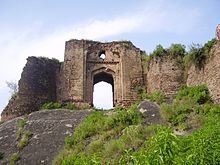Rawalpindi
![]()
This article is about the city in Pakistan; for the district of the same name, see Rawalpindi (district); for the British passenger ship of the same name, see Rawalpindi (ship).
![]()
This article or subsequent section is not sufficiently supported by evidence (e.g., anecdotal evidence). Information without sufficient evidence may be removed in the near future. Please help Wikipedia by researching the information and adding good supporting evidence.
Rawalpindi (Punjabi and Urdu راولپنڈی) is a city on the Pothohar Plateau in the Punjab province of Pakistan. Until the completion of the seat of government in Islamabad, Rawalpindi was the provisional seat of the government of Pakistan from 1958 until the 1960s. The industrial city has a population of 2 million. The headquarters of the Pakistan Army is located in the city. Islamabad International Airport is also actually located in Rawalpindi and serves both cities.
Climate and inhabitants
The literacy rate is 70.5 % (as of January 2006). The population is ethnically and linguistically heterogeneous, with Pothoharis, Punjabis, Muhajirs and Pashtuns.
The weather is difficult to predict. The average annual rainfall is 910 millimeters. In summer, the maximum temperature reaches up to 52 °C, while in winter it can drop to -5 °C.
Population development
| Census Year | Population |
| 1972 | 614.809 |
| 1981 | 794.843 |
| 1998 | 1.406.214 |
| 2017 | 2.098.231 |
The population of the agglomeration is expected to exceed 5.1 million by 2050.
Places of interest
Despite its rapid development into a large city, Rawalpindi has many good hotels, restaurants, clubs, museums and parks, of which Ayub National Park is the largest. Rawalpindi is the starting point for tourists visiting the resorts in the Galyat region, such as Murree, Nathia Gali, Ayubia, Abbottabad, Swat, Kaghan, Gilgit, Hunza, Skardu or Chitral.
The city has two main roads: Grand Trunk Road runs roughly east-west and is also known as the Mall. Murree Road runs north from the Mall and crosses the railway lines before skirting the eastern tip of the Old City and continuing on to Islamabad. The two main bazaars are the Raja Bazaar in the Old City and the Saddar Bazaar, which developed between the Old City and Grand Trunk Road as the Military District Bazaar.
The populated avenues of the old city are home to many attractions, including Hindu and Sikh temples and Muslim shrines.
Thanks to its history, Rawalpindi is also home to the Pakistan Army Museum, where information about colonial and contemporary armies, arsenals and war heroes is presented.
Ayub National Park is located beyond the old presidential residence on Jhelum Road. It occupies an area of about 9.3 sq km and has a playground for children, a lake with boats, an aquarium and a garden restaurant. On Murree Road, you will find the Rawalpindi Public Park, which was opened in 1991. Here one can find play facilities for children, lawns, fountains and flower beds.
The Rawalpindi Cricket Stadium, built in 1992, has a grass pitch, floodlights and a capacity of 15,000 spectators. The home team is called Rawalpindi Cricket Association. The hockey stadium of Rawalpindi also holds about 10,000 spectators.
Rawat Fort is located 17 kilometers east of Rawalpindi, on the Grand Trunk Road towards Lahore. It was built in the early 16th century by the Gakhars, a proud and independent tribe of the Pothohar Plateau. Inside the structure is the tomb of a Gakhar leader named Sultan Sarang Khan. He died in 1546 fighting against the forces of Sher Khan Suri. If you dare to step on the broken steps inside the tomb, you will get a great panoramic view of the plateau with the Mankiala Stupa. About an hour from Rawalpindi, on the same road towards Peshawar, lies the Attock Fort. The former fort is easy to see and is close to the shrine of Hazrat Jee Sahib, the traditional burial place of the Bati family of the Paracha clan from the nearby (abandoned) village of Malahi Tola.
Pharwala Fort is located about 40 kilometers away from Rawalpindi beyond Lehtrar Road. It is another Gakhar fort built in the 15th century on the ruins of the Shahi Fort, which was a Hindu site from the 10th century. General Babur captured the fort in 1519 and later, in 1825, the Sikh expelled the defeated Gakhars from the fort. Although in a crumbling state, it is still an attraction for lovers of forts, even though it is only open to Pakistani visitors due to its location in the military zone.

The Pharwala Fort

The Murree Road
Search within the encyclopedia